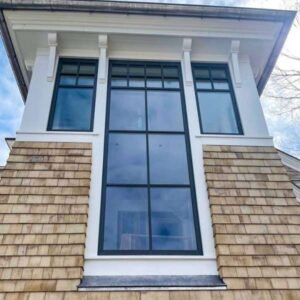Opening Mechanisms: Tilt-and-Turn vs. Traditional Options
The most striking difference you’ll notice is how the windows operate. Traditional Canadian windows typically feature casement designs that crank outward, hung windows that slide vertically, or sliders that move horizontally. While functional, these designs are limited to a single opening mechanism.

European windows, however are renowned for their innovative tilt-and-turn functionality. With just one handle, you have two distinct options:
Tilt mode allows the top of the window to angle inward, creating a secure opening for draft-free ventilation. This is ideal for rainy days or when you want air circulation without compromising security.
Turn mode lets the entire window swing inward like a door, making it incredibly easy to clean both sides of the glass—even on upper floors. This also provides a safe emergency exit when needed.

This versatile dual functionality is a major reason why homeowners across the Greater Toronto Area are choosing European windows and doors from Double G Windows & Doors.
Energy Efficiency: Engineered for Harsh Climates
While both European and Canadian windows must meet energy standards, European windows are often designed to satisfy some of the world’s most demanding energy codes, including Passive House requirements. They typically include features that are considered premium upgrades in Canada:
Multi-Chamber Frames: European window frames are generally thicker with multiple internal air chambers that provide superior insulation.
Triple Glazing: Double glazing is standard in Canada, but triple glazing is the norm for European windows, adding an extra barrier against heat loss.
Advanced Sealing: The multi-point locking mechanism on tilt-and-turn windows pulls the sash firmly against the frame, creating an exceptionally airtight seal that eliminates drafts and energy waste.
In Canada’s climate—with brutal winters and hot summers—this enhanced thermal performance means significantly lower heating and cooling costs year-round.
Durability & Longevity: Built for the Long Haul
Canadian windows are certainly durable, but European windows are engineered with exceptional robustness in mind. They’re constructed using premium materials like uPVC, aluminum, and wood/aluminum composites. The multi-point locking system doesn’t just enhance security -it distributes pressure evenly across the frame, preventing warping and extending the window’s lifespan.
This emphasis on long-term performance means minimal maintenance and decades of reliable service. Though the upfront investment may be higher, the savings from reduced energy bills and fewer repairs make it worthwhile over time.
Aesthetics: Sleek, Minimalist Design
If you’re drawn to contemporary design, European windows deliver. They feature slim, elegant frames and expansive glass surfaces that maximize natural light and provide unobstructed views. The concealed hardware and streamlined single-handle design create a minimalist aesthetic that can transform both the exterior appeal and interior ambiance of your home.
You can even customize your windows with various colors and finishes to perfectly match your home’s style.
The Bottom Line
When selecting new windows for your home, it’s important to weigh all factors carefully. While Canadian-made windows are reliable and familiar, European windows deliver superior energy efficiency, enhanced security features and a sleek modern design that can substantially improve your home’s comfort and resale value.
For Canadian homeowners, the growing preference for European windows reflects their proven long-term benefits. When you work with a company that understands both window styles, you can make an informed decision that suits your lifestyle and protects your investment.



